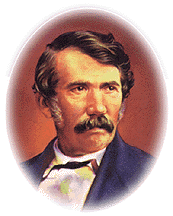
David Livingstone
A Missionary Heart & Soul
It's hard to imagine Africa once
being called the "dark continent." Yet this is exactly what it was to the
outside world less than 150 years ago. However, thanks to the relentless efforts and
commitment of David Livingstone, Africa became a land open not only to civilization but to
the gospel of Jesus Christ.
Mrs. J.H. Worchester writes in her book, David Livingstone:
First To Cross Africa With The Gospel, that "as a missionary explorer, [Livingstone]
stood alone, traveling 29,000 miles in Africa, adding to the known portion of the globe
about a million square miles, discovering lakes N'gami, Shirwa, Nyassa, Morero and
Bangweolo, the upper Zambesi and many other rivers, and the wonderful Victoria Falls. He
was also the first European to traverse the entire length of Lake Tanganyika, and to
travel over the vast water-shed near Lake Bangweolo, and through no fault of his own, he
only just missed the information that would have set at rest his conjectures as to the
Nile's sources."
After hearing of his death, Florence Nightingale said:
"God has taken away the greatest man of his generation...."
Livingstone was born on March 13, 1813, in Blantyre,
Scotland, where he spent the first twenty-three years of his life. His parents, devout
Christians, played an important role in his life by introducing him to the subject of
missions.
As a young man, he worked in a local mill, but refused any
thought of this becoming his destiny. By the time he turned twenty-one, Livingstone had
accepted Christ and made up his mind to become a medical missionary.
He heard of Robert Moffat, a missionary to South Africa,
tell of the work going on in Kuruman. Within eighteen months, he saved enough money to
continue his education. After completing medical school, he accepted a position with the
London Missionary Society in South Africa. And on December 8, 1840, he set sail for
Kuruman.
A Coast To Coast Venture
However, upon his arrival he was disappointed by the small
population of Africans living in the region. He was determined to reach a larger
population. A year later, he was granted permission to move 700 miles into the African
interior to establish another missionary station. Livingstone wasted no time setting
things up at Mabotsa.
In 1845, he returned to Kuruman where he met and married
Robert Moffat's daughter, Mary. Their marriage lasted eighteen years and witnessed the
birth of four children.
Livingstone often took his family with him while crossing
the African wilderness. Still, there were many times when they could not be together. The
longest period of separation was for five years between November of 1853 and May 1856.
Livingstone completed one of the most amazing journeys ever undertaken - a coast to coast
venture that covered four thousand miles of unexplored land, most of which was located
along the Zambezi River.
Sorrow And Victory
After an extended visit to England, Livingstone and his wife
began their last journey together. It was during this adventure that Livingstone faced the
severest trial of his life; Mary died in 1862 from complications related to African
fever.
Sorrow and discouragement plagued Livingstone: "It was
the first heavy stroke I have suffered, and quite takes away my strength. I wept over her
who well deserved many tears. I loved her when I married her, and the longer I lived with
her I loved her the more."
After several failed attempts to set up mission stations in
the interior and along the coast, Livingstone concluded God was leading him in another
direction. No European had ever ventured into North Africa. This would be his next goal
and his greatest accomplishment for future missionary work. The charts and maps he left us
changed the way we view Africa.
"I am a missionary, heart and soul," wrote
Livingstone. "God had an only Son, and He was a missionary and a physician. A poor,
poor imitation of Him I am, or wish to be." In this service I hope to live; in it I
wish to die." No other person has done more to further mission efforts than David
Livingstone.
Marching inland in 1866, Livingstone reached Lake Nyasson on
August 8 and began journeying north toward Lake Tanganyika. He wrote: "O Jesus, grant
me resignation to Thy will, and entire reliance on Thy powerful hand...The cause is Thine.
What an impulse will be given to the idea that Africa is not open if I perish
now!..."
Livingstone was often weakened by bouts of African fever.
Months rolled by and then years without the outside world knowing where he was. This is
when a New York reporter, Henry Morton Stanley, accepted the challenge to "find
Livingstone."
On November 10, 1871, Stanley's caravan, loaded with
supplies, reached Ujiji, Africa. A thin, frail Livingstone stepped out to meet him as
Stanley bowed, took off his hat, and spoke the now famous words, "Dr. Livingstone, I
presume."
Beloved The World Over
Livingstone was beloved and honored by the world. Yet when
Stanley found him, he was weak and undernourished. The two quickly began a friendship.
After Livingstone's death, it was Stanley who diligently worked to see missionaries
serving in the land his friend had opened.
Death came to David Livingstone on April 30, 1873, after a
long illness. His African companions reported they found him kneeling beside his bed where
he had said his last earthly prayer. His body, along with his belongings - papers and maps
- was transported to Bagamoyo on the coast and then sent to England, where he is buried in
Westminster Abbey. |
